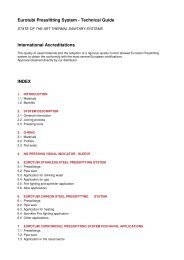Vis PDF - Damstahl
Vis PDF - Damstahl
Vis PDF - Damstahl
You also want an ePaper? Increase the reach of your titles
YUMPU automatically turns print PDFs into web optimized ePapers that Google loves.
Chapter 3: Applications of Common Stainless Steel Alloys<br />
EN 1.4404 / AISI 316L<br />
The low-carbon edition of 4401, and the standard material<br />
for most of the pharmaceutical industry world-wide.<br />
4404 is the most common stainless steel for “critical”<br />
parts where the common 4301 or 4306/7 just are not<br />
good enough. 4404 is <strong>Damstahl</strong>’s best sold acid resistant<br />
steel type and available in almost any shape and condition<br />
including a large array of fittings.<br />
EN 1.4418 / -<br />
Comparatively low-alloyed, acid resistant steel, mostly<br />
available as rods or bars. The content of only 1 % Mo and<br />
4-6 % Ni makes the steel two-phased and mechanically<br />
strong, and frequently, it is used for hydraulic equipment;<br />
sometimes even plated with hard-chromium.<br />
Very popular for Norwegian offshore use.<br />
Due to their high elongation (> 45 %), the<br />
austenitic steels are very ductile and perfect<br />
for any kind of mechanical deformation, such<br />
as deep-drawing. These flanges are made of<br />
EN 1.4404.<br />
EN 1.4432 / AISI 316L<br />
Developed by the Finnish pulp and paper industry, this 2.5 % Mo steel<br />
resembles the 4435 a lot. However, the Cr content is marginally lower,<br />
and so is Ni. Due to the 2.5 % Mo, 4432 is slightly more corrosion<br />
resistant than the normal 4404 without adding too much to the price.<br />
The downside is lower availability.<br />
EN 1.4435 / AISI 316L<br />
The low-carbon edition of 4436 and thereby a high-alloy 4404.<br />
Like 4432 and 4436, the extra 0.5 % Mo gives a higher corrosion resistance; however, the main<br />
drawback is the high alloy costs due to Mo and Ni. Consequently, 4435 is the most expensive and<br />
the most corrosion resistant standard alloy and, for economical reasons, the steel is frequently hard<br />
to get.<br />
EN 1.4436 / AISI 316<br />
High-alloyed, acid resistant steel, containing 2.5-3.0 % Mo as compared to 2.0-2.5 for normal 4401<br />
or 4404. The extra Mo improves the corrosion resistance, whereas the drawback is the higher price,<br />
partly because of the increase in Mo and partly because of the extra Ni required to maintain the<br />
austenite phase.<br />
EN 1.4539 / ”904L”<br />
Containing 20 % Cr, 25 Ni and 4.5 Mo, the 4539 is very corrosion resistant, austenitic steel. Originally<br />
developed to handle general corrosion in strong sulfuric acid, which explains the high Ni content<br />
and the 1.2 % Cu. “Over-austenitic” alloy possessing excellent corrosion resistance in almost any<br />
environment, but due to the high Ni content, 4539 is very expensive. Please note that the designation<br />
“904L” is not an AISI standard, but rather an antique Swedish factory name.<br />
www.damstahl.com<br />
01.2013<br />
290
















